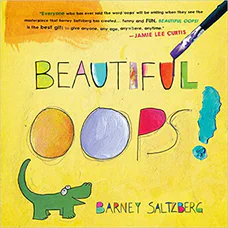Beautiful Oops
Written and illustrated by Barney Saltzberg
28 pages
•
Published 2010 (Workman Publishing Company)

Recommended Age Range: Preschool through 2nd grade.
Publisher's Summary:
A spill. A smear. A smudge. A tear. When you think you have made a mistake, think of it as an opportunity to make something beautiful! A life lesson that all parents want their children to learn: It’s OK to make a mistake. In fact, hooray for mistakes! A mistake is an adventure in creativity, a portal of discovery. A spill doesn’t ruin a drawing—not when it becomes the shape of a goofy animal. And an accidental tear in your paper? Don’t be upset about it when you can turn it into the roaring mouth of an alligator.

Dr. Annie's Takeaways
Recommended for: Children who are perfectionistic about their artwork (or other types of activities) will benefit from this book’s fun, concrete introduction to the idea that mistakes can be great opportunities for creativity. It leads well into doing an art project of turning one’s own artistic blemishes (e.g., tears, smudges) into beautiful creations.
Would a child like it? Many children would enjoy this book, especially if it’s paired with a relevant art activity. It gives a child permission to be a little messy, and it’s a lovely antidote to the message that a child must color within the lines.
Evidence-Based Practices:
Cognitive Restructuring
Tone: Matter-of-fact, encouraging
Story Quality: This book is a series of examples of how, with a little imagination, mistakes (e.g., a tear, a spill, a smudge) can be turned into something beautiful (a crocodile’s mouth, an elephant, a magical rabbit). There’s not a story, per se, but the examples are engaging.
Illustrations: The illustrations drive the content of this book. There are great 3D elements (e.g., a telescoping hole that can be pulled out and peered through), and the “mistakes” look super realistic. The creations made from the mistakes aren’t so perfect that a child would be intimidated by them. They’re imperfect, which really is perfect for this book.
Representation: There are no characters in this book. It’s just a series of creative examples of turning a blemish into something beautiful.
Psychological Practices: Like The Book of Mistakes
, this book encourages a child to shift their thinking from a mistake being a bad thing, to a mistake being an opportunity. The examples are all related to art, but it’s a useful metaphor for other types of mistakes as well. This book has an interactive companion book, My Book of Beautiful Oops!: A Scribble It, Smear It, Fold It, Tear It Journal for Young Artists
which provides a number of different prompts (e.g., on a page with a lot of holes: “Holey moley! Those could be faces, or fish, monsters, or a whole lot of things!”; “Someone scribble-scrabbled on this page. Look closely and make anything you like!”) that encourage a child to think creatively and turn something they might initially see as a flaw into something they’re proud of. Both books encourage creative problem solving and shifting one’s thinking about mistakes to be more flexible and ultimately resilient.
Concerns: None
